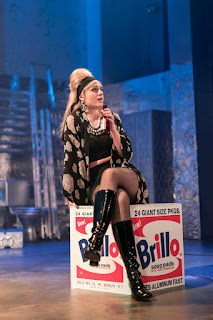They say you should never judge a book by it's cover - but sometimes it saves an awful lot of time. My issues with Josie Rourke's production of SWEET CHARITY began right at the top of the show and fluctuated throughout the evening. I suppose any show is open to be re-imagined but when the production constantly gets in the way of the material then you know the director probably has no understanding of the original's worth.
Musicals don't have a continuous life for over 50 years because of the concepts visited on it, and while I am sure SWEET CHARITY will survive Rourke's attempts to make it 'relevant', she might walk with a limp for a while.
As I said the sinking feeling started before a note was sung. For some reason Rourke and designer Robert Jones have decided that the defining stage image for their SWEET CHARITY is the silver and metallic world of Andy Warhol's Factory. Showing crashing obviousness they must have surmised that as SWEET CHARITY premiered in 1966 they should look for images of New York in the mid-1960s and the first thing they found was The Factory.
The production starts with the cast all in black on black outfits, sitting around in icy hauteur while a film of the Empire State Building is projected on the back wall and The Velvet Underground's whacked-out VENUS IN FURS blares out. I would dearly love to know what this has to do with SWEET CHARITY and it's sleazy world of neon-lit dance halls, blaring car horns along 42nd Street, and shadowy men smelling of cheap after-shave? This world is wonderfully conjured up in Cy Coleman's exciting Overture - which, of course, Rourke dropped.
As I said any production where the Concept takes precedence over the material's internal logic is bound to fail - with Rourke it reaches the height of stupidity when Helene and Nicky, Charity's fellow-dancehall hostesses, sing BABY DREAM YOUR DREAM after Charity quits the business to seek happiness with boyfriend Oscar. They sing cynically about Charity's future, but ultimately it dawns on them that her hopes will probably never happen to them and the song ends on a sad, wistful note. So what does Rourke have them doing while they sing it? Walk on with large Brillo boxes - a la Warhol - and unpack smaller Brillo boxes from inside, Russian doll style... which end up all over the stage... and which are swept away in the scene change. So a nothing idea meaning nothing which results in... nothing.
The always wobbly end to the show again plays right into Rourke's cack-handed Concept. The original production has Charity alone again, her happy dreams collapsed, but she admits that at least he didn't steal her purse like the guy before did so picks herself up and heads off as titles appear saying "And she lived - hopefully - ever after". Bob Fosse shot two endings to the film version - one truthful, one happy - but went with the truthful version. But Rourke isn't dealing with characters, she is dealing in Concepts and worse, an Agenda. So she ends with Charity and the Fandango Dance-Hall girls lined up reprising THERE'S GOTTA BE SOMETHING BETTER THAN THIS like so many Times Square Miserables. Needless to say, Rourke's attempt to claim Charity for the #MeToo movement just comes across as crashingly Obvious. Hamlet famously says "The play's the thing.." but sadly thanks to the oppressive Director Theatre climate of today, the Agenda's the thing.. no matter whether it serves the material.
One of the disappointments of the show was Wayne McGregor's choreography. In a show so famous for it's dance numbers - especially Fosse's moves - McGregor's choreography is either remarkably basic or remarkably absurd: HEY BIG SPENDER is choreographed with about six step-ladders for the Dance-Hall divas to clamber up or lounge on then descend to move somewhere else on a revolve. Because they are not busy enough singing one of the show's great standards. The RICH MAN'S FRUG number was more successful with a stage full of quaking Andy Warhols look-a-likes.
So where do we find the positives? Anne-Marie Duff can certainly act the role - and her honeyed rasp of a voice did finally grow on me - but something seemed off about the performance, as if she didn't really commit to the wide-eyed optimism of Charity. Whether the fact that she is the oldest actress to play Charity in London or New York has anything to do with that is open to conjecture. She is always likeable however.
It's an odd CHARITY where the most memorable performance is from the actor playing Oscar but Arthur Darvill was excellent in the role. He gave us a totally believable character who was ready to commit to Charity but ultimately unable to leave her past behind. The Donmar has hit on the odd idea of having a regular guest performer play Daddy Brubeck for short periods - we got Kobna Holdbrook-Smith, fresh from his Olivier Award-winning Ike Turner in TINA. His sparkly silver shirt made the biggest impression sadly.
Lizzy Connolly and Debbie Kurup were ok as Nickie and Helene but - along with Martin Marquez as Italian matinee idol Vittorio Vidal and Stephen Kennedy as Herman the grouchy manager of the Fandango club - everyone seemed to be acting on a fairly low-light. It's almost like they are all using 40w bulbs instead of iridescent neon.
SWEET CHARITY currently sits on my list of favourite musicals and there was still enjoyment to be had thanks to the combined excellence of Cy Coleman's music, Neil Simon's book and Dorothy Fields' lyrics but they had to fight hard to get through the vacuous trappings of Josie Rourke's Concept. Oh I didn't mention the lifesize plastic-ball pit that doubles as Central Park lake...
Never mind Charity, you will survive till the next time we meet...









No comments:
Post a Comment